Archives: Blog
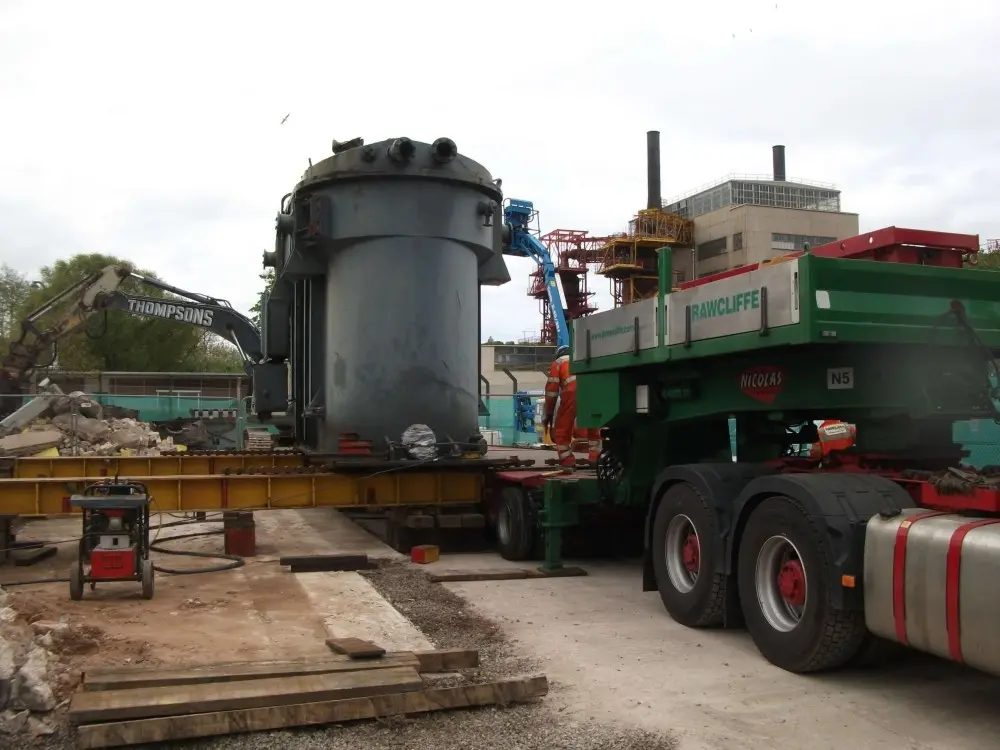
What is jacking and skidding and when should it be used?
Transporting and handling large, heavy objects in smaller spaces requires specialist equipment. Usually, cranes or self-propelled modular transporters (SPMT) are chosen for manoeuvring abnormal loads and heavy goods, but even they cannot be used at times.
When space is limited, jacking and skidding are the go-to options for many heavy haulage companies. But, what are jacking and skidding and how are they used?
Continue reading this insightful guide to find out.
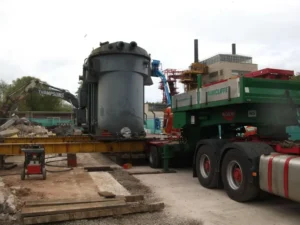
What is jacking and skidding?
Jacking and skidding is a technique used to move heavy goods when there is not enough space for a crane or SPMT.
There are several different types of jacks available to use. Three of which are: climbing, cylinder and strand.
Climbing jacks are hydraulically powered and can raise and lower heavy loads.
Cylinder jacks lift loads to a position where climbing jacks can be placed underneath and transport the goods. Once the climbing jack is out of the way, they can also lower the object to ground level.
Strand jacks contain a hydraulic cylinder which moves a cable through the jack and allows the load to be lifted or lowered.
Skidding systems are also powered by hydraulics and enable precise positioning across a range of different industrial projects. They’re made of two main parts: skid shoes and skid beams.
Both the skid shoes and the load travel along the skid beams using a self-locking hydraulic propulsion system.
What are the benefits of using a strand jack system?
Due to being automatic solutions, strand jacks can lift and lower without any personnel at the jacks whilst also possessing pre-set overload protection.
Strand jacks also provide remote control monitoring and mechanical fail-safe gripping mechanisms, if required. They can be adjusted at various speeds, to, automatically synchronising irrespective of loads.
Additionally, strand jacks can hold their load mechanically rather than hydraulically when movement is stopped. A counterbalance valve ensures smooth and controlled lowering.
Another benefit strand jacks offer is their lifting capacity with some models capable of lifting up to 1405 tons.
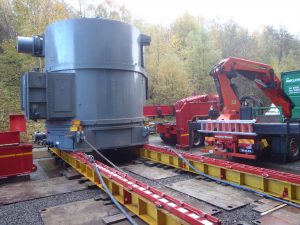
When and how is jacking used?
Jacking systems are used in the heavy haulage industry when there are restrictions to access or cranes cannot be used.
When access is restricted or a crane cannot be used, abnormal loads can be lifted and loaded by a jacking system.
Different types of jacking systems can be used depending on the load. For example, strand jacks are used for a suspended load or to position it over a skid track for horizontal movement. Hydraulic and mechanical jacking systems are used to elevate a load, and there must be a strong and stable foundation when lifting vertically.
Hydraulic and mechanical jacks can be used with skidding systems. For example, the load is jacked up and then moved horizontally to its new position with a skidding system. These operations are effective for lifting and moving loads within buildings or for installations at a site with restricted space.
Strand jacks are flexible, allowing for different types of configurations. They can be used as a single device or with multiple devices, making them suitable for both onshore and offshore operations in a range of industries.
Because the clamps in a strand jack have a crushing effect, they have a limited number of lifting operations but the length of the strands can vary depending on the lifting requirements for each task.
When and how is skidding used?
Skidding systems are capable of moving all kinds of different loads, ranging from one ton to over 1000. Cranes are not always the best – or safest – option for horizontal load movement, so skidding systems are often favoured, especially if space is limited.
Hydraulic skidding systems tend to have the same essential components: tracks, skid shoes and hydraulic cylinders.
Skidding systems are used to horizontally transport abnormal loads that would otherwise be very dangerous to lift with a crane. Moving them slowly and carefully along skid tracks makes it safe for everybody in the surrounding area, and ensures the goods remain undamaged.
A jacking system would lift the goods onto the skidding system, where they would then be taken to their destination. Skidding systems can only transport goods in a straight line, so if turns are required, the goods would need to be lifted and placed on another track.
Skidding systems have been in regular use since the 1980s and remain one of the safest ways to transport huge objects. They’re not just for heavy objects, though.
Skidding systems are often used in small spaces and are useful for transporting goods down a hallway, for example. Specialised rigs can be used to move power transformers down the hallways of hospitals or office buildings.
Choose JB Rawcliffe & Sons for jacking and skidding
Do you require the expert services of a heavy haulage company that can move your goods using jacking and skidding systems?
If so, you’re in the right place! At JB Rawcliffe & Sons, we have decades of experience in this industry and know the exact type of equipment required for every job.
Simply contact us today and we can talk about your requirements. Call 01695 737 880 or send an email to enquiries@jbrawcliffe.com to speak to a member of our team.
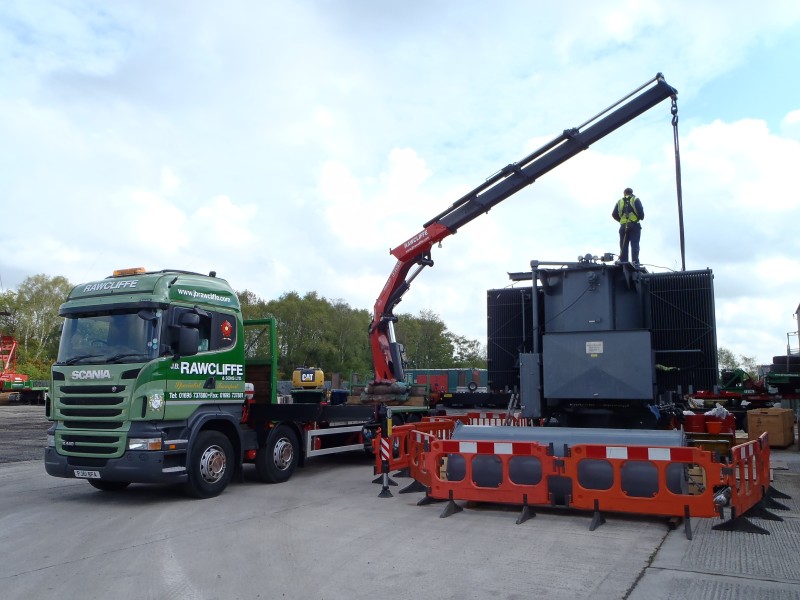
What can a HIAB crane lift?
If you’re a business that regularly requires the transportation of heavy goods, a HIAB crane can be useful.
These powerful machines can perform a variety of lifting and transportation tasks and are used around the UK daily by thousands of businesses.
Interested in using a HIAB crane but unsure of what they can lift? Continue reading to find out everything!
What is a HIAB crane?
HIAB (Hydrauliska Industri AB) is a Swedish brand name that’s synonymous with crane-mounted lorries because of their reliable quality since their creation in 1944.
A HIAB crane is a crane-mounted truck that can both lift and transport heavy objects using their bed, making them a useful piece of equipment for businesses of all sizes and sectors.
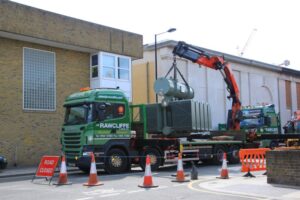
What can you lift with a HIAB crane?
HIAB cranes allow businesses and machinery movers to lift and transport a huge range of materials and objects. Whatever sector you specialise in, you can benefit from a HIAB crane.
Here’s what you can lift with a HIAB crane, from industry to industry.
Industrial equipment
- HVAC units – Heating, ventilation and air conditioning units are heavy and require precise placements.
- Generators and transformers – Heavy pieces of equipment can be safely lifted, strapped down and transported.
- Machinery parts – Large machines have individual components that require specialised lifting and transportation.
Construction materials
- Concrete blocks and slabs – Concrete elements that are used in foundations and walls can be difficult to transport without a HIAB crane.
- Bricks and roofing materials – Pallets of tiles, bricks and other building materials can easily be lifted and transported – safely – with a HIAB crane.
- Roof trusses – Critical roofing components are large and cumbersome, but a HIAB crane can safely transport them on their beds, as well as unload them at the destination.
- Steel beams – A HIAB crane can easily lift, transport and place steel beams in a precise location.
Landscaping and agriculture
- Farm equipment – HIAB cranes have the power to lift tractors and farming machinery and then deliver them somewhere else for maintenance, for example.
- Soil and fertiliser – Huge quantities of soil, fertiliser and compost can be efficiently transported via a HIAB crane.
- Trees and plants – Moving huge trees and large plants improves the efficiency of a landscaping task with a HIAB crane.
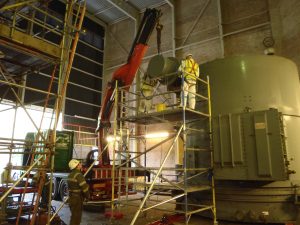
Shipping and logistics
- Pallets – Pallets packed full of a variety of goods, whether it’s furniture, electronics, or raw materials, can be handled with ease by a HIAB crane.
- Bulk items – Timber, scrap metal and other heavy materials can easily be lifted and transported on the back of a HIAB crane.
- Shipping containers – Shipping containers – even filled with goods – can be lifted and transported on a HIAB crane, improving the logistics and transportation for this sector.
- Cabins – Portable cabins can be transported to construction sites and other locations with a HIAB crane.
What are the benefits of a HIAB crane?
As we’re sure you can imagine based on the amount of objects a HIAB crane can comfortably handle, there are several benefits to using one.
A HIAB crane offers businesses of all sizes an efficient way to transport their large and heavy items with a vehicle that combines loading and unloading with transportation.
Precision
A HIAB crane features a powerful hydraulic system that allows for precise control and ensures that all items are lifted and placed exactly where they’re intended.
When hiring a heavy haulage company to transport your goods, you’ll be keen on ensuring precision is an essential focus. With a HIAB crane, you’ll be pleased to know your goods will be lifted carefully and placed exactly where you need them.
Mobility
The key benefit of a HIAB crane is its ability to transport the items it lifts. In the haulage industry, many pieces of equipment are loaded onto a large lorry with another piece of equipment, like a forklift truck. The goods are then transported to another location and are only unloaded with another piece of machinery.
With a HIAB crane, everything is combined. The goods can be lifted, transported and unloaded by the HIAB crane.
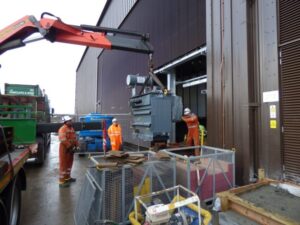
Efficiency
Cutting out other pieces of machinery and equipment that are otherwise required for loading and unloading, a HIAB crane provides efficiency and speed.
Easily load, transport and unload on-site with a single piece of machinery, improving the productivity of the entire process.
Versatility
A HIAB crane can lift an enormous range of objects from a variety of different industries. Whatever sector your company specialises in, you’ll benefit from a HIAB crane.
HIAB cranes can lift almost anything from pallets of bricks or sand to portable cabins and heavy-duty shipping containers.
HIAB crane hire at JB Rawcliffe & Sons
If you require the services of a reliable and professional heavy haulage company to transport your heavy goods, you can benefit from expert HIAB crane hire services from JB Rawcliffe & Sons.
We can provide fantastic HIAB crane hire for clients all over the UK thanks to our extensive fleet with lifting capabilities to suit every task. Whatever your goods, we’ll ensure we can meet your requirements.
Interested in our HIAB crane services? If so, contact us today by calling 01695 737 880 or by sending an email to enquiries@jbrawcliffe.com.
A member of our team will be happy to discuss your haulage needs and go through our HIAB crane hire options.

How to choose the right heavy haulage provider
Choosing the right heavy haulage company is an important decision for your own business. Failure to opt for a reputable company can damage your company’s reputation, harm your day-to-day operations, negatively impact your supply chain and hurt customer relationships.
If your clients are relying on you to provide a product, you must put your trust in a professional haulage company.
At J.B. Rawcliffe & Sons, we understand the importance of a reliable heavy haulage service more than most – which is why we’re here to help you.
Read on to find out how you can choose the right heavy haulage transport company to take your heavy equipment from one place to the next.
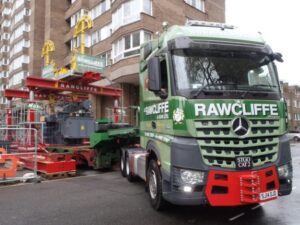
How can a professional haulage company benefit you?
If your company is regularly transporting goods across the UK and you’re struggling to keep up with the demands of hauling abnormal loads, then a heavy haulage company is ideal for you.
Not only will they handle the difficult task of transporting goods from point A to point B, but they provide cost savings.
Heavy haulage companies have their heavy haulage vehicles that can transport heavy loads like construction equipment while providing a service quality you’d expect.
Hauling companies have all the equipment and the right vehicles for every type of job, something you’re unlikely to possess. They can also provide escort vehicles for a particularly abnormal load, as well as other services you’re unlikely to match – saving you time, resources and money.
7 tips for choosing a reputable company for heavy haulage
So, you have some goods that you need transporting and you require the services of a heavy haulage company? Follow our tips to ensure you pick the right company.
Consider the cargo
Before choosing the right heavy haulage company, you must first recognise exactly what you need to transport.
A reliable heavy haulage company will be able to handle all kinds of abnormal loads, but you may have a particularly complex piece of equipment to transport. This will need specialised support, especially if it’s extremely large.
Experience matters
Experience is one of the key factors in choosing a heavy haulage business to transport your goods. You may find a new business in your area that looks great on the surface, but it lacks the experience that other companies in the area may possess.
Heavy haulage is a complex task and you want to ensure your goods – which are likely expensive – are in the hands of somebody you can trust to get the job done efficiently.
Find a company with a long history of successful heavy haulage tasks; look up customer reviews and case studies, and speak to other business owners you know who have used a haulage company previously.
Don’t opt for the cheapest quote
Running a business can be expensive, especially in the modern era, and saving pennies everywhere you can is essential.
However, when it comes to transporting your expensive, heavy goods, choosing the cheapest offer could end up costing you more in the long run.
It’s also important to remember that the lowest quote could include hidden fees.
Your best bet is to reach out to multiple companies for quotes and compare them. The lowest quote may well be the best service but you should at least compare to others.
If you get a suspiciously low quote from one heavy haulage company, it’s probably best to stay away in case they have a poor track record and include hidden costs to bring the price up.
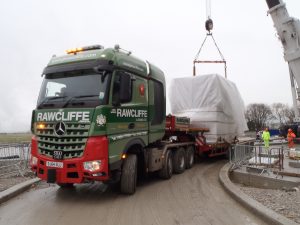
Check for other services
It’s wise to check if a heavy haulage company can provide services other than simply transportation. Because heavy haulage is such a complex industry and jobs can vary massively depending on the load and distance involved, it’s beneficial if a company can offer more than just transportation.
You may find a heavy haulage company that is willing to go above and beyond to offer you bespoke, excellent service.
Who knows, you may even need this company for other services further down the road and you’ll be thankful you set up a relationship with them now.
Check insurance
You should check the heavy haulage company for insurance coverage. Ensure their driver is fully covered and that the company is insured in case of a crash or damage to your goods.
The last thing you want after hiring a company is your expensive goods to be damaged in transit and you have to foot the bill.
Prioritise customer service
How is the heavy haulage company on the phone? Are they friendly and attentive or standoffish and rude?
Are they open to discussing the entire task at hand, the goods that need transporting or are they a little short and straight to the point?
You’ll get a feel for how a business may perform based on how they interact with you. If you get a bad vibe when speaking to them, do not trust them with your heavy loads.
Do they have a modern fleet?
How new are the heavy haulage company’s vehicles?
When speaking to the company, ask them questions about the fleet, such as its age and condition and what type of vehicles it has available.
If they have a limited number of vehicles or their current stock is outdated, it may be best to opt for a different heavy haulage company.
Are they environmentally responsible?
Finally, are they eco-friendly?
In 2024, businesses must be environmentally responsible so if you find a heavy haulage company that isn’t, you should probably avoid them.
Companies that demonstrate their care for the environment show an empathetic side and are likely to care more about the quality and efficiency of their delivery. They can also future-proof your supply chain against regulation changes.
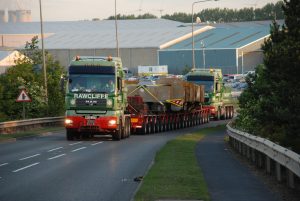
Choose the most reliable heavy haulage company in the UK
So, you’re ready to find a reliable, efficient and professional heavy haulage company. Luckily we know just the one – us!
At J.B. Rawcliffe & Sons, we believe we’re the best choice for transporting heavy goods around the UK. Here’s why:
- We’re environmentally responsible
- We prioritise customer service
- Our modern fleet is unrivalled
- Our insurance covers everything
- We’re certified
- Our service is excellent value for money
- We have incredible experience in all types of heavy haulage
If you’re still undecided on which heavy haulage company to opt for, why not contact us and speak to a member of our team? We’ll be happy to discuss your heavy haulage needs and how we can help you.
Simply call 01695 737880 or send an email to enquiries@jbrawcliffe.com.
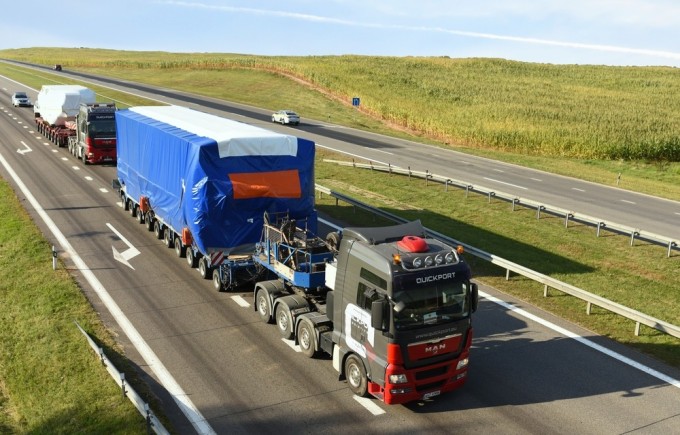
Why Precision Matters in Heavy Haulage at J.B. Rawcliffe & Sons Ltd
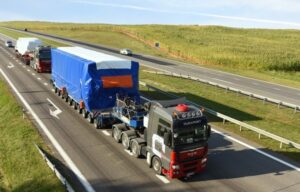
Almost any industry can benefit from heavy haulage transportation. And, in our 45-plus years of working in the transportation industry, we’ve worked with companies in a variety of sectors.
We are leaders in UK heavy haulage and have covered every aspect of transport and haulage – ensuring precision, safety and efficiency at every step.
Whether it’s using escort vehicles or examining every detail of a task, we take accuracy and precision importantly at JB Rawcliffe and Sons.
Continue reading to find out why.
What is heavy haulage?
Heavy haulage is the movement of abnormal and oversized goods and objects that cannot be dismantled and transported using standard means of distribution.
Large, cumbersome goods are transported using specialist equipment and machinery. Regular haulage is simple transportation from one location to another, but heavy haulage involves a lot more planning and strategy to ensure the oversized equipment safely reaches its destination.
Heavy haulage not only requires more, in-depth planning but also specialist equipment and experienced and qualified drivers to safely transport the freight.
Which type of heavy haulage can we transport?
Most industries can take advantage of heavy haulage services – especially from JB Rawcliffe & Sons.
Heavy haulage is ideal for transporting heavy, oversized items that are too big to fit on standard or large vehicles.
The type of cargo we can transport with our specialised vehicles includes:
- Turbines
- Helicopters
- Bungalows
- Generators
- Cooling towers
- Aircraft parts
In our decades of hauling heavy goods, we have safely transported objects from the construction, defence, industrial, marine, and oil and gas industries.
Goods we have transported include the ones listed above and so much more – all thanks to our highly qualified drivers and high-quality specialist lifting equipment and vehicles.
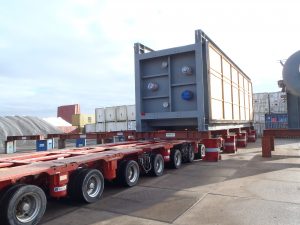
Why is precision important in heavy haulage in the UK?
Precision and accuracy are vitally important to JB Rawcliffe & Sons.
If we put in all the hard work in the build-up to the actual transportation of a company’s goods, it makes our jobs much easier and ensures a safe and efficient delivery.
Failure to check the correct dimensions of the goods can lead to choosing the wrong vehicle for the task. Similarly, if we do not investigate the pick-up and drop-off locations, difficulties may arise during transportation. This could result in choosing a vehicle too large to access both or either location.
And finally, the route must be planned to ensure our vehicles and the goods can safely navigate the roads en route.
What are the four key planning aspects in ensuring precision in heavy haulage?
1. Find out as much information as possible
To efficiently complete a heavy haulage task, we must be as informed as possible. This involves discovering the size and weight of the goods in question, where they’re being picked up from and where they’re being delivered.
Figuring out every possible piece of information about the heavy haulage task at hand is the best possible way of setting ourselves up for a successful delivery.
As a general rule of thumb, we always ask our customers for the same information, which is:
- Collection and delivery locations
- Details of the goods, including dimensions and weight
- Loading requirements (i.e. forklift, tail lift)
- Preferred delivery dates and times
If all customers provide the relevant information to us, we can start effectively planning which vehicle(s) to use, the pick-up location, the route and the destination.
2. Choosing the correct equipment and vehicle
Once all information has been collected, we can discuss the correct vehicle to use.
What do we have to choose from, though?
- Bogies
- HIAB cranes
- Modular equipment
- Platform trailers
- Prime movers
- Semi-low loaders
- Self-propelled modular transporters (SPMT)
We must know the dimensions and weight of the goods because heavier objects may require an escort vehicle.
An abnormal load is classed as weighing more than 44,000kg, a width of more than 2.9 metres and a length of more than 18.65m. If the goods in hand tick these boxes, we will arrange an escort vehicle.
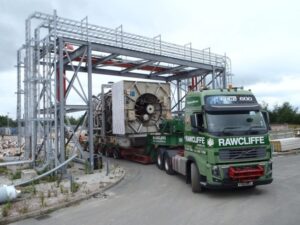
3. Research both pick-up and drop-off locations
The third key aspect to successfully planning a heavy haulage task is to take a detailed look at points A and B.
For instance, where is the pick-up location, and are there any entry or overhead restrictions? This could be as simple as the entrance to the pick-up location being positioned on a narrow street or low-hanging trees nearby.
Also, what is the ground condition like?
Once we gain entry to the pick-up location, do we need any specialised equipment to lift the goods onto our vehicle?
Then, similar questions should be asked about the destination. Precision and efficiency are at the forefront of everything we do – and these questions must be answered before we can accurately pick up and deliver any goods.
4. Plan the route
Now, it’s time to plan the route. Once we’ve figured out any restrictions at the two locations, the size of the goods and chosen the correct vehicle, it’s all about working out the most suitable route.
This includes checking the types of roads we’ll be navigating, avoiding any that are too small, and ensuring a timely and safe delivery.
Fortunately, all of our team are highly qualified and experienced in planning, loading, delivering and unloading heavy equipment.
Reliable and efficient heavy haulage services
At JB Rawcliffe & Sons, we pride ourselves on offering the most efficient and professional heavy haulage services across the entire United Kingdom.
All of our success is based on the hard work we put in before picking up your goods. Precision is key in everything we do, and it shows with each pick-up and delivery we complete.
Without putting in the time at the research and planning stage, we would simply not be able to provide the high-quality service that we pride ourselves on.
Do you have oversized equipment and machinery that requires safe and reliable transportation? Don’t wait any longer. Contact us today by filling in our contact form, calling 01695 737 880, or emailing enquiries@jbrawcliffe.com.
